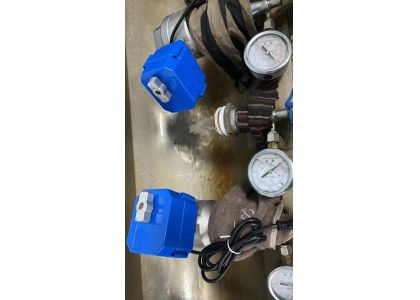
Motorised valves are indispensable equipment in modern industrial automation and water treatment sectors, rendering troubleshooting of such valves particularly crucial. Failure to promptly identify potential hazards in motorised valves may result in serious safety risks and significant economic losses.
Before commencing troubleshooting of potential faults, please ensure you have the following ready:
1. Disconnect the power supply to the motorised valve actuator.
2. Close the pipes at both ends and drain the medium from the pipes.
3. Prepare the manual and motorised valve wiring diagram for the motorised valve actuator.
4. Prepare all necessary tools for dismantling the motorised actuator valve.
Identify the fault symptoms and make a diagnosis
Common faults
A: When a signal is applied to the electric actuator, the valve does not move.
B: When a signal is applied to the electric actuator, the valve fails to open fully or close fully.
C: Insufficient sealing, resulting in leakage issues
D: Motor overheating causing actuator failure
How to troubleshoot the issue of valve not actuating
1. Check the power supply
Measure whether the main supply voltage connected to the actuator matches the specified voltage for the actuator, such as 12V, 24V, 220V, or 380V.
2. Output Electrical Signal Inspection
Check whether the signal output lines of the PLC/DCS are short-circuited.
Verify that the output electrical signals are correct, typically 4-20mA or 0-10V.
3. Manual Valve Operation Check:This constitutes a critical step in diagnosing valve body malfunctions and electrical faults.
Attempt to close the valve by turning the handwheel or using the handle.
Should manual closure prove impossible, this indicates the valve body is seized, contains foreign matter within the valve core, or exhibits rusted bearings.
Processing: The valve must be dismantled for a comprehensive inspection and repair.
If it is possible to manually close the valve.The fault lies in the electrical components of the electric actuator.
1. Inspect the motor for short circuits, checking internal wiring for loose connections, detached components, or signs of overheating and burn damage.
2. Check controller settings for any disabled modes
3. Verify whether incorrect electrical or mechanical limit switches are preventing the motorised actuator valve from operating
4. Inspect whether the controller or positioner has failed and requires replacement
How to troubleshoot a 2 port motorised valve failing to fully open or close
1. Feedback device malfunction
A faulty or severely worn feedback device may cause the actuator to receive erroneous position signals, preventing the valve from opening or closing to the correct position as instructed.
2. Faulty Control Signals
Electrical interference corrupting signals causes the electric actuator to receive erroneous commands.
3. Internal Wear
Severe stem wear results in excessive travel.
4. Insufficient Torque
Actuator torque being too low causes the valve to halt before fully opening or closing.
How to troubleshoot sealing issues in motorised valves
Internal leakage in valves
Damage to sealing surfaces due to mutual wear between sealing rings and valve seats
Large particulate impurities in the medium becoming lodged at the valve plug position, preventing complete closure
Electrical and mechanical limit switch issues preventing the valve plug from closing fully
External leakage from the valve
Severe wear of the packing
Wear or loosening of the bonnet gasket
Damage to the sealing ring
How to Troubleshoot Motor Overheating Issues
1. Check whether the power supply voltage exhibits significant fluctuations or instability
2. Excessive torque from the electric actuator causing prolonged motor overload
3. Excessively frequent opening and closing operations exceeding the motor's operational capacity
4. Excessive resistance at the connection point between the actuator and valve stem causing motor overload
5. Damage to the motor bearings
Summary
To troubleshoot faults in electric actuator valves, follow the sequence: power supply → electrical signal → manual operation → mechanical/electrical limit switches. This approach enables precise diagnosis of most issues. Consult the instruction manual to resolve faults efficiently.